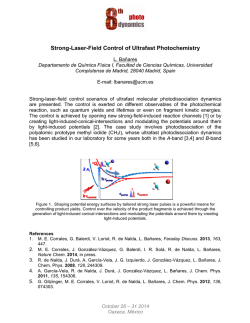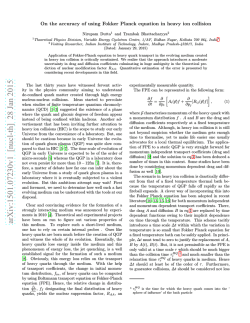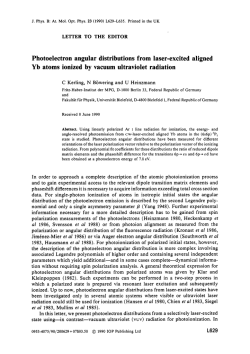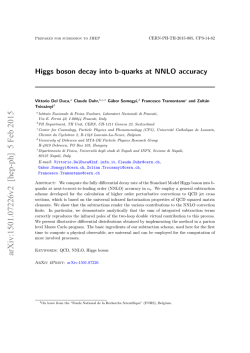
arXiv:1501.06773v1 [hep
Strings from domain walls in SYM and QCD(adj) Mohamed M. Anber,1 Erich Poppitz,2 and Tin Sulejmanpaˇsi´c3 arXiv:1501.06773v2 [hep-th] 3 Feb 2015 1 Institute de Th´eorie des Ph´enomen`es Physiques, ´ Ecole Polytechnique F´ed´erale de Lausanne, CH-1015 Lausanne, Switzerland 2 Department of Physics, University of Toronto, Toronto, ON M5S 1A7, Canada 3 Department of Physics, North Carolina State University, Raleigh, NC 27695, USA (Dated: February 4, 2015) We study strings between static quarks in QCD with nf adjoint fermions, including N = 1 Super Yang-Mills (SYM), in the calculable regime on R3 × S1 . We find that they have many qualitatively new features not previously known. The difference from other realizations of abelian confinement is due to the composite nature of magnetic bions, whose Dirac quantum with fundamental quarks is two, and to the unbroken part of the Weyl group. In particular we show that strings are composed of two domain walls, that quarks are not confined on domain walls, that strings can end on domain walls, and that “Y” or “∆” baryons can form. We briefly discuss their lightest modes and decompactification limit. While ubiquitous in nature, color confinement is one of the least-understood features of Yang-Mills (YM) theory. Theoretically controlled approaches usually involve models that differ, in various ways, from real-world QCD. Nonetheless, one’s hope is that their study will reveal features of confinement that transcend the particular model. A rare theoretical laboratory where confinement is under theoretical control within field theory is offered by QCD(adj): an SU (Nc ) YM theory with a strong scale Λ and nf Weyl fermions in the adjoint representation, compactified on R1,2 × S1L with fermions periodic around ¨ the spatial S1 of size L. Unsal showed [1] that for LNc Λ 1 confinement is due to the proliferation of topological molecules—the magnetic bions. These are non-selfdual correlated tunneling events composed of various fundamental and twisted [2, 3] monopole-instantons. For small but finite LNc Λ, magnetic bion confinement extends the 3d Polyakov mechanism of confinement [4] to locally-4d theories qualitatively different from 3d theories with fermions where confinement is lost [5]. In passing, we note that QCD(adj), bions and their constituents are studied in connection with deconfinement, resurgence, theta-dependence and volume independence, e.g. [6–18]. The goal of this paper is to study confining strings in QCD(adj)/SYM in the calculable regime. We find that they have an interesting structure, to the best of our knowledge not previously discussed in confining strings studies. We shall see that, while still abelian in nature, QCD(adj) strings retain more features expected in the nonabelian theory compared to other theories with abelian confinement. At distances L massless QCD(adj) on R3 × S1L dynamically abelianizes [1]. Ignoring fermions for the moment, for SU (2) gauge group the effective bosonic (Euclidean) Lagrangian is: m2 (cosh 2φ − cos 2σ) LB = M (∂µ σ)2 + (∂µ φ)2 + 2 + (nf − 1)Vpert. (φ) ] . (1) The scales and fields in (1) are as follows. The scale M is of order g 2 /L, where g 2 is the weak 4d gauge coupling at the scale 1/L. The scale m ∼ exp(−4π 2 /g 2 )M is nonperturbative (4π 2 /g 2 is the action of a monopole-instanton) and exponentially small. With exponential-only accuracy (for pre-exponential factors, see [8, 19]) one can think of M as the cutoff scale of our effective theory and of m as the mass scale of infrared physics. The long-distance theory (1) has two bosonic fields. The field φ describes the deviation of the trace of the Wilson line around S1L from its center symmetric value. Equivalently, φ is the radial mode of the adjoint Higgs (the Wilson line) breaking SU (2) → U (1). The field σ is dual to the photon in the unbroken Cartan subalgebra (the τ (3) direction) of SU (2). In Minkowski space (3) M ∂0 σ ∼ F12 is the magnetic field, and M ij ∂j σ ∼ Ei (3) is the electric field (where ij = −ji and i, j = 1, 2). As is clear from the discussion of scales, the terms in (1) proportional only to M are perturbative. We shall not need the explicit expression [1, 8] for the perturbative potential Vpert (φ). This term is absent for SYM (nf =1). For nf >1, Vpert stabilizes φ at the center symmetric value and gives it mass of order M , hence φ can be integrated out. The relative normalization between the potentials for φ and σ given in (1) is for SYM. Of most interest to us is the origin of the nonperturbative terms in (1). The nonperturbative potential for φ, ∼cosh 2φ, is due to neutral bions [8, 20] and will not play an important role here (except for being the only source stabilizing φ at the center-symmetric value φ=0 in SYM). The other term, ∼cos 2σ, is of utmost importance to us, as it captures the effect of the magnetic bions—the leading cause of confinement in QCD(adj). The factor of two in the argument of the cosine reflects their composite nature: they have magnetic charge two while fundamental monopole-instantons have unit charge. This term is responsible for the generation of mass gap for gauge fluctuations (mass m for the dual photon σ) and for the confinement of electric charges. The theory (1) has two vacua σ=0, π, both with φ=0, corresponding to the spontaneous breaking of the anomaly-free discrete chiral sym- 2 Kink i e2 H C 1.0 A(3) 0.8 winds by 2⇡ 0.6 R 0.4 FIG. 1: Left: the Wilson loop and the monodromy of σ. Right: Sketch of the confining string configuration σ ¯ with the correct monodromy, composed of two domain walls. The dot and cross represent probe quarks a distance R apart. The maximum distance between the walls, of thickness 1/m, is d. metry (the R-symmetry in SYM). Confinement is detected by the area law for the Wilson loop in a representation R,Htaken along a closed contour C, W (C, R)≡ TrR P exp(i C A). For an SU (2) fundamental representation, we needHto compute the Rexpectation value of W (C, 12 ) ∼ exp( 2i C A(3) )= exp( 2i S B (3) ). Here A(3) is the (electric) gauge field in the Cartan direction, B (3) =dA(3) is its field strength, and S is a surface spanning C (the omitted second contribution to the trace of the fundamental Wilson loop gives an identical area law). Insertion of the Wilson loop in the dual language of the σ field (recalling that σ∼σ + 2π) amounts to the following instruction [4]: erase the contour from the space, and have σ wind by 2π for any contour which has linking number one with the Wilson loop—a 2π monodromy (see left panel of Fig. 1). Take a rectangular contour in the y−x-plane (y is Euclidean time) with span T (R) in the y (x)-direction. For infinite R and T , σ jumps by 2π upon crossing the y−x plane. If the potential in (1) was—as in Polyakov’s original 3d SU(2) gauge theory with an adjoint Higgs field—cos σ, the field configuration extremizing the action (1) with the correct monodromy, which we denote σ ¯ , would be equivalent [4] to a domain wall with y−x-plane worldvolume, where σ ¯ would change by 2π as z varies between ±∞. We would have W (C, 21 ) ∼ e−Σstr RT , with string tension Σstr proportional to the domain wall tension (for a recent review see [21]). The physical difference between monopole-instanton confinement in the 3d Polyakov model and QCD(adj) on R3 × S1 —the fact that the magnetic bions have magnetic charge two—is reflected in the cos 2σ potential (1). Now, the σ ¯ -field configuration with the right monodromy has to be more complicated than a single domain wall. To study it, we keep the time (y) extent of C infinite and consider a finite spatial (x) extent R. As the σ ¯ configuration has monodromy 2π across C, in this simple one-field case it is clear that (since the periodicity of the cos 2σ potential is π) the string has to be composed of two domain walls. To get a picture of the extremal con- 0.2 FIG. 2: The action density of the confining string σ ¯ obtained by numerically minimizing, via Gauss-Seidel relaxation, the action (1) with the correct monodromies. The lattice has spacing 1/M , size 100 × 100, and M/m = 20. The classical log R growth of the transverse separation from the model of Fig. 1 is also seen to hold upon studying different size strings. figuration, consider Fig. 1, with parameters R, d defined in the caption. A sketch of a two-domain wall configuration is shown, with the second infinite worldvolume direction (the time y) perpendicular to the page. The action has two parts, excluding contributions from the junctions (subleading at large R): the tension of the two domain walls, proportional to twice their area (we take T (R + d) as the area) and the wall-wall long-distance repulsion (∼e−md ). Thus, S ∼ M mT (R + d) + M mT Re−md , up to numerical factors. Extremizing with respect to d, we find md∗ ∼ log mR, a logarithmic growth of the transverse size of the confining string configuration with the separation between the probe charges. Remarkably, the above simple model captures the behavior of the actual extremum of (1), shown on Fig. 2, including the log R growth of the transverse size. Our remarks so far also hold for deformed-YM theory [22], where, for θ=π [23] the single monopole contribution vanishes. The adjoint fermions were, so far, ignored. Their Cartan components have an effective Lagrangian [1] h i ¯ σ µ ∂µ λ + m cos σ [(λλ)nf + h.c.] . (2) LF = M iλ¯ 2M nf −1 We omitted, for brevity, a summation over the nf flavor indices in the kinetic term and a product over the flavor indices in the interaction term (the ’t Hooft determinant in the monopole-instanton background). The field φ is also set to its vanishing vev. For SYM, apart from omitting φ, (2) has correct normalization. It is, in fact, the effect of the fermions on the confining string where the difference between SYM and QCD(adj) with nf >1 shows up most profoundly. In SYM, the fermions are massive in the σ=0, π vacua. They have exact zero modes in a single domain wall 3 background, with exponential fall off away from the wall. Because of the gap m in the bulk, the fermion induced wall-wall interaction is expected to be exponentially suppressed, ∼m2 e−cmd , c≥1 (a calculation of the determinant, requiring some mild background modeling even for parallel walls, yields attraction with c>1). The fermion-induced exponential interaction at large d is furm ther accompanied by an “~”∼ M loop suppression factor, hence the classical bosonic repulsion between the walls ∼ M me−md dominates. Thus, in SYM the logarithmic growth of the transverse string size is not affected by the fermions. The log R growth of the string transverse size is reminiscent of the behavior of magnetic strings (ANO vortices) which confine monopoles on the Higgs branch of N =2 SQCD [24]. However, the underlying semiclassical physics is different; in particular, as opposed to [24], our strings obey the usual area law with tension ∼M m. In contrast to SYM, in non-supersymmetric QCD(adj) with nf >1 the Cartan components of the nf Weyl adjoints are massless, due to the unbroken SU (nf ) chiral symmetry. Thus, despite the fact that their interaction with the wall in (2) is highly suppressed, they induce a power-law force competing with the exponential repulsion at large d. The leading effect of the fermions occurs at 2nf −1 loop order; its calculation, of which we just give the result, is similar in spirit to Casimir energy calculations. Fermion loops are found to generate a wall-wall attraction at large d. Per unit volume, it is m 4nf ∼ −m2 M (md)−4nf +4 , dominating the bosonic repulsion ∼ M me−md at large d. The expression for the action of our toy model, with fermion attraction included, m 4nf is S = R(T + d)M m + RT M me−md − RT m2 M / (md)4nf −4 . The extremum condition (to which the area term does not contribute for large T ) is now e−md ∼ 2 2 e−4π (4nf +1)/g /(md)4nf −3 . At small g 2 , we thus have 2 md∗ ≈ 4π (4nf + 1)/g 2 , a stable wall-wall separation parametrically large compared to the single domain wall width. Numerical confirmation of the stabilized transverse size d∗ of the string is challenging, but our estimate of the size stabilization is reliable at small g and large R. As a consequence of the stabilized transverse size of the confining string in nf >1 QCD(adj), the second translational Goldstone mode, the “breather” mode of the two walls, is now gapped even at infinite R. The gap for this mode, mbr , can be estimated by taking the second derivative of the wall-wall interaction potential at 2 2 d∗ , mbr ∼ me−4π 2nf /g . The breather mode mass mbr is a new scale on the string worldsheet, well below the “glueball”—the bulk mass gap m for gauge fluctuations. The fact that the strings are composed out of domain walls (DW) – a situation opposite to what was suggested in [25] – has drastic implications on how the fundamental quarks interact with DWs. For SU (2) there are two types of DWs, which we label BPS1 and BPS2 , and their anti-walls. The distinction is in the electric fluxes which they carry, but they both satisfy the same BPS equation, e.g. [26]. The fundamental string is made out of 1) 2) 3) FIG. 3: A sketch of how a q q¯ pair can fuse into the DW (from left to right). The shaded and white regions represent distinct vacua of the theory. The solid black line represents the BPS1 DW, while the dashed line represents the anti-BPS2 DW, while the arrows represent their electric fluxes. The black dots are the quark and the anti-quark. The inlay in the upper left corner shows a fundamental string ending on a DW. the BPS1 and an anti-BPS2 , where each carries 1/2 of the fundamental electric flux. If a quark anti-quark (q q¯) pair is in the vicinity of the DW, however, the DW flux can cancel part of the flux of a q q¯ pair, and absorb it into its worldsheet, see Fig. 3. The q q¯ pair on the DW would then be liberated, as all the tension of the pair has been absorbed into the DW tension. This leads to deconfinement in the DW worldsheet. This is reminiscent of the DW localization, where a theory in the DW worldsheet is in Coulomb phase, so that quarks are liberated [27]. We also note that in a certain Higgs vacuum of 4d theories, monopole–anti-monopole pairs have support on stable non-abelian strings [28, 29]. Deconfinement of quarks on the DW also implies that strings can end on DWs (see inlay of Fig. 3). In MQCD, SYM strings have been argued to end on DWs and a heuristic explanation by S.-J. Rey [30], using the vacuum structure and ideas about confinement, is given in [31]. The phenomenon was subsequently explored from modeling the effective actions of the Polyakov loop and gaugino condensates [32]. Here, we found—for the first time, to the best of our knowledge—an explicit realization of this phenomenon in a field theory setting where the confining dynamics is understood. Our discussion of confining strings in QCD(adj) generalizes to the higher-rank case. We shall focus only on a few salient points. All fields in (1) become Nc −1 dimensional vectors, describing the light degrees of freedom left after SU (Nc )→U (1)Nc −1 breaking. It suffices to study H ~ (3) i~ λ· C A the operator W (C, λ) = e , with ~λ—a weight of R Nc −1 (a vector of U (1) electric charges), as the trace of the Wilson loop is obtained by summing over all weights of R. As in (1), semiclassically hW (C, λ)i ∼ e−Sclass [¯σ(C)] , with the magnetic bion potential Lbion = −m2 M Nc X i=1 h i ∗ cos (~ αi∗ − α ~ i+1(mod σ , (3) Nc ) ) · ~ 4 } } } W W-pairs 2MW mbr ⇤ ⇠⇤ 1 L FIG. 4: A sketch of the abelian string spectrum, corresponding to the tower of W W -bosons pairs attached to the double string, and the breather mode excitations mbr . replacing the one in (1). Here α ~ i∗ label the simple (i<Nc ), ∗ 2 affine (i=Nc ) coroots (|~ αi | =2); M and m are, up to ~ are set to their irrelevant factors, as in (1). The fields φ ~ vev φ=0; the full Eq. (3) is in [8] for n√f >1 and √ [33] for SYM (to get back (1), use α1∗ =−α2∗ = 2, λ=1/ 2 and redefine m, M, σ). Clearly, a string between quarks with charges ~λ should have 2π~λ monodromy of ~σ around C. An important fact, with crucial consequences for the string spectrum, is that, due to the existence of the twisted (affine) monopole-instanton [2] and the preserved center symmetry, a ZNc subgroup of the Weyl group, cyclically permuting the Nc roots in (3), is unbroken in QCD(adj). Denoting by P the generator of the cyclic Weyl group, using an Nc -dimensional basis for the roots (one linear combination of the Nc σk ’s decouples [8]), its action is: P σk =σk+1(modNc ) , or P α ~ k =~ αk+1(modNc ) . The P symmetry ensures that strings confining quarks in R of SU (Nc ) have equal tension for all weights of R that lie in the same orbit of the cyclic Weyl subgroup. Since P permutes the Nc weights of the fundamental representation, strings confining any component of the fundamental quarks have equal tension. This is different from SeibergWitten theory where the Weyl group is completely broken [34]. Still, the multiplicity of meson Regge trajectories in the calculable regime of QCD(adj) is different from that expected in the full nonabelian theory with unbroken Weyl group. Further, for higher N -ality representations, there are different “P -orbits” of “k-strings” (both previous statements hold without accounting for screening by heavy “W bosons”). We leave a full taxonomy of “k-strings” in QCD(adj) for the future and briefly study strings between fundamental quarks. From the P symmetry, it suffices to take ~σ monodromy 2π w ~ 1 , appropriate to the highest weight of the fundamental (the Nc −1 fundamental weights w ~k obey α ~ p∗ ·w ~ k =δkp , p=1,...,Nc −1). We shall argue that these strings are also composed of two domain walls. To this end, recall [8] that SU (Nc ) QCD(adj)/SYM has Nc vacua, h~σ i= 2πk ~, k=1,...Nc , related by the broken Nc ρ PNc −1 ZNc (⊂Z2Nc nf ) chiral symmetry. Here, ρ ~= k=1 w ~ k is the Weyl vector and the dual photons’ periodicity is ~σ '~σ + 2π w ~ k . An “elementary” domain wall between the 2π k-th and (k+1)-th vacua then has monodromy N ρ ~. To c construct a configuration of 2π w ~ 1 monodromy, we notice 2π 2π ρ ~− N Pρ ~. A ~σ monodromy 2π w ~1 the identity 2π w ~ 1= N c c can now be engineered from an elementary domain wall and a P -transformed anti-domain wall, as in Fig. 1. A numerical minimization of (3) confirms that, indeed, this is the string configuration in nonsupersymmetric QCD(adj) with Nc =3, 4 (the action density plot is similar to Fig. 2). We also note that, contrary to Seiberg-Witten theory where only linear baryons exist [35], in QCD(adj) baryons in “Y” or “∆” configurations arise naturally. The affine monopole-instanton and the unbroken part of the Weyl symmetry are, again, crucial for this. The combinatorics of such a construction follows from the above string picture. We shall not discuss the energetics determining the preferred configuration here. For Nc >2 SYM, the challenge is to include the now rel~ σ coupling (φ and σ decouple only in SU (2) at evant φ-~ g1 [33]); for now, we note that candidate string configurations with the right monodromies can be engineered from appropriate BPS and anti-BPS walls. A very interesting question is how our QCD(adj) strings behave upon decompactification to R4 . In SYM, no phase transition occurs and the transition to R4 should be smooth. For nf >1, the SU (nf ) chiral symmetry is expected to break, at least for sufficiently small nf [36] (since fermions play crucial role in both magnetic bion formation and in stabilizing the string size, one might expect interesting interplay between chiral symmetry breaking and confinement here). On R4 , not much is known about strings in SYM or QCD(adj) from field theory alone. An exception is softlybroken Seiberg-Witten theory [34] (not pure SYM). In MQCD, the transition from softly-broken Seiberg-Witten theory to pure SYM was studied in [35]. It was found that pure SYM strings on R4 conform, at least in the MQCD regime, to the behavior expected from nonabelian strings, with fully unbroken Weyl group and N -ality-only dependent tensions. The transition from the different abelian behaviors, found here and in [34], to the nonabelian one should clearly involve the W -bosons (as they become light upon increasing L). Their inclusion can modify both the vacuum configurations and the confining strings themselves (a pure YM theory scenario, relating monopoles, W -bosons, and center vortices is in Ch. 8 of [37]). The difficulty in pursuing this transition is, not surprisingly, the loss of theoretical control upon de-abelianization. It is, however, tempting to speculate, at least in SYM where continuity is guaranteed, that the gapped modes due to the double string will be responsible for the truly non-abelian structure of the string in the decompactification limit. In the abelian regime the “non-abelian” excitation spectrum would correspond to the exponentially small breather mode mbr , and a tower of W -bosons. Then, upon decompactification it is reasonable to expect the abelian string-spectrum to go into the non-abelian spectrum (see Fig. 4). 5 Acknowledgements We thank Soo-Jong Rey, Mithat ¨ Unsal and Alyosha Yung for discussions. EP acknowledges support by NSERC and hospitality of the Perime- ter Institute in the Fall of 2014. MA acknowledges the Swiss National Science Foundation. [1] M. Unsal, Phys.Rev. D80, 065001 (2009), 0709.3269. [2] K.-M. Lee and P. Yi, Phys.Rev. D56, 3711 (1997), hepth/9702107. [3] T. C. Kraan and P. van Baal, Nucl.Phys. B533, 627 (1998), hep-th/9805168. [4] A. M. Polyakov, Nucl.Phys. B120, 429 (1977). [5] I. Affleck, J. A. Harvey, and E. Witten, Nucl.Phys. B206, 413 (1982). [6] M. M. Anber, E. Poppitz, and M. Unsal, JHEP 1204, 040 (2012), 1112.6389. [7] E. Poppitz, T. Schafer, and M. Unsal, JHEP 1210, 115 (2012), 1205.0290. [8] P. C. Argyres and M. Unsal, JHEP 1208, 063 (2012), 1206.1890. [9] G. Basar, A. Cherman, D. Dorigoni, and M. Unsal, Phys.Rev.Lett. 111, 121601 (2013), 1306.2960. [10] M. M. Anber, Phys.Rev. D88, 085003 (2013), 1302.2641. [11] E. Shuryak and T. Sulejmanpasic, Phys.Lett. B726, 257 (2013), 1305.0796. [12] E. Poppitz and T. Sulejmanpasic, JHEP 1309, 128 (2013), 1307.1317. [13] M. M. Anber and T. Sulejmanpasic (2014), 1410.0121. [14] F. Bruckmann and T. Sulejmanpasic, Phys.Rev. D90, 105010 (2014), 1408.2229. [15] G. Bergner and S. Piemonte, JHEP 1412, 133 (2014), 1410.3668. [16] T. Misumi and T. Kanazawa, JHEP 1406, 181 (2014), 1405.3113. [17] T. Misumi, M. Nitta, and N. Sakai (2014), 1409.3444. [18] R. Larsen and E. Shuryak (2014), 1408.6563. [19] M. M. Anber and E. Poppitz, JHEP 1106, 136 (2011), 1105.0940. [20] E. Poppitz and M. Unsal, JHEP 1107, 082 (2011), 1105.3969. [21] M. M. Anber, Annals Phys. 341, 21 (2014), 1308.0027. [22] M. Unsal and L. G. Yaffe, Phys.Rev. D78, 065035 (2008), 0803.0344. [23] M. Unsal, Phys.Rev. D86, 105012 (2012), 1201.6426. [24] A. Yung, Nucl.Phys. B562, 191 (1999), hep-th/9906243. [25] A. Armoni and M. Shifman, Nucl.Phys. B664, 233 (2003), hep-th/0304127. [26] K. Hori, A. Iqbal, and C. Vafa (2000), hep-th/0005247. [27] G. Dvali and M. A. Shifman, Phys.Lett. B396, 64 (1997), hep-th/9612128. [28] M. Shifman and A. Yung, Phys.Rev. D86, 025001 (2012), 1204.4165. [29] M. Shifman and A. Yung, Int.J.Mod.Phys. A29, 1430064 (2014), 1410.2900. [30] S.-J. Rey, unpublished work (1997). [31] E. Witten, Nucl.Phys. B507, 658 (1997), hepth/9706109. [32] A. Campos, K. Holland, and U. Wiese, Phys.Rev.Lett. 81, 2420 (1998), hep-th/9805086. [33] M. M. Anber, E. Poppitz, and B. Teeple, JHEP 1409, 040 (2014), 1406.1199. [34] M. R. Douglas and S. H. Shenker, Nucl.Phys. B447, 271 (1995), hep-th/9503163. [35] A. Hanany, M. J. Strassler, and A. Zaffaroni, Nucl.Phys. B513, 87 (1998), hep-th/9707244. [36] E. Poppitz and M. Unsal, JHEP 0909, 050 (2009), 0906.5156. [37] J. Greensite, Lect.Notes Phys. 821, 1 (2011).
© Copyright 2025







![arXiv:1501.07877v1 [hep-ex] 30 Jan 2015](http://s2.esdocs.com/store/data/000480916_1-3222ec79447e4cecd07304389d05d043-250x500.png)
